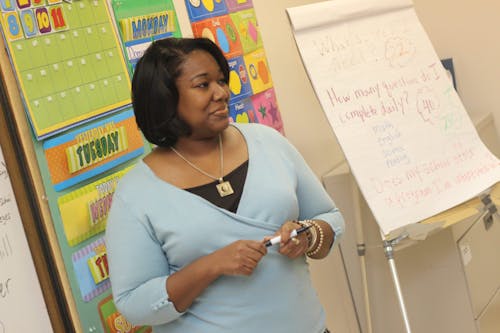- Meet students at the door. Welcome each child into your class. Say good morning/afternoon. Call students by their name.
- Ensure students are quiet before entering the room. If the students are loud in the hall, they will come into your room the same way. At the door, make sure the students are quite, orderly, shirts tucked in (if you're at a uniform school), etc. Whatever you want to see in your room, ensure that's what you see prior to their entrance.
- Positive reinforcement. Use phrases like, "I like the way Ashley, came in the class" or "Thank you Mike for being on task." This will let the class know what you are looking for and most will strive to give you just that. If you use Class Dojo or Classcraft, give out 3 times as many positive points as negative.
- Develop a rapport. Demonstrate that you care about the students. Ask them about their day or weekend. Assign a Student Inventory and use the data from that in classwork. For example, if you know Luis likes soccer, then put a soccer problem on an assignment and use Luis's name.
- Be consistent. Put rituals and routines into place as soon as possible. Students need to know what your expectations are sooner rather than later. If you are inconsistent, students' behavior will mirror that. When students don't know what the expectations are, they are more likely to display off-task behavior. "Being consistent doesn't mean being a robot or a machine. It arises out of our caring for our students, and caring for their learning." (Smith, 2004).
- Criticize/compliment the behavior, not the child. Describe the behavior. Concentrate on telling the student exactly what they are doing to cause us grief. Only deal with what is happening at the moment, the what happened in the past or what we think will happen in the future. Be firm and friendly. Being firm and friendly says to the student, "What you are doing must stop now, but I still like you." (Albert, 1996). Use descriptive language, not judgmental language. (Cangelosi, 1993).
- Don't be afraid to apologize. "Public humiliation outweighs a private apology." (Smith, 2004) If you ridicule a student in public and need to apologize, then apologize the same way. Apologizing shows the students that you are human. The apology is like you are also apologizing to the class too.
- Kids Culture - Expose yourself to their favorite shows, movies, music, etc. This allows you to have something to talk about with your students, which in turn, helps you to develop a relationship with them.
- Start each day as a new one. No matter what your students did yesterday, that was in the past. We can't punish them for what they did the day before. Each day students need to start with a clean slate. In my opinion, this one may be the most important.
- Identify the reason for misbehavior: attention, power, revenge, or avoidance-of-failure (Albert, 1996).
- Attention-Seeking Behavior:
- Use proximity.
- Give "The Eye"
- Positive Reinforcement
- Name Dropping
- Power and Revenge Behaviors
- Time out
- Acknowledge the students' power
- Remove the audience
- State both viewpoints
- Avoidance-of-Failure Behavior
- Stage an "I Can't" Funeral
- Modify instructional methods
- Require two "put-ups" for every put-down.
- Encourage positive self-talk
References
Albert, L., PhD. (1996). Cooperative Discipline. Circle Pines, MN: American Guidance Service.
Cangelosi, J. S. (1993). Classroom Management Strategies (2nd ed.). White Plains, NY: Longman.
Smith, R. (2004). Conscious Classroom Management. Fairfax, CA: Conscious Teaching Publications.



















